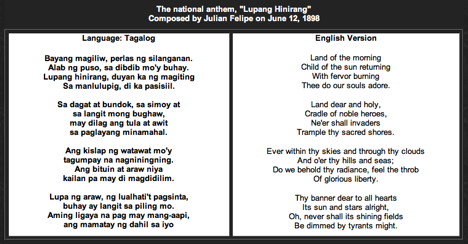Who Wrote The National Anthem Entitled Awit Sa Paglikha Ng Bagong Pilipinas
Hymn to the Creation of the New Philippines also known by its incipit Tindig. Pre colonial era.
25112013 The translation of Lupang Hinirang was used by Felipe Padilla de Leon as his inspiration for Awit sa Paglikha ng Bagong Pilipinas commissioned as a replacement anthem by the Japanesecontrolled Second Philippine Republic during World War II and later adapted during the Martial Law Era under Ferdinand Marcos.

Who wrote the national anthem entitled awit sa paglikha ng bagong pilipinas. American era A Industrial art B. Aking Inang Bayan English. In August 1899 Jos.
Aking Inang Bayan English. Ang unang itinawag dito ay. It was commissioned during the Japanese occupation of the Philippines and intended to supplant Lupang Hinirang as the national anthem.
He wrote the national anthem during the Japanese period ended At sa Paglikha ng A Modem era 7. Is a patriotic song written by Filipino composer Felipe Padilla de Len. He wrote the national anthem during the Japanese period entitled Awit sa Paglikha ng Bagong Pilipinas A.
2 It was commissioned during the Japanese occupation of the Philippines and intended to. This art use for or utility changing of raw materials for tarian purposes. During the American colonial rule of the Philippines the Spanish lyrics of the anthem was translated into English titled The Philippine Hymn by a Filipino writer Camilo Osias and an American AL.
My Motherland is a patriotic song written by Filipino composer Felipe Padilla de Len. Hymn to the Creation of the New Philippines also known by its incipit Tindig. Lupang Hinirang originally titled in Spanish as the Marcha Nacional Filipina is the national anthem of the Philippines.
It was after adpoted as the lyrics to the anthem. Awit sa Paglikha ng Bagong Pilipinas Hymn to the Creation of the New Philippines also known by its incipit Tindig. Aking Inang Bayan is a patriotic song written by Filipino composer Felipe Padilla de Len.
Na isinulat ni Jose Palma sa tang 1899 sa wikang EspaolAng tugtugin ng awit na ito ay isang marcha. He wrote the national anthem during the Japanese period entitled Awit sa Paglikha ng Bagong Pilipinas. 03112020 Awit sa Paglikha ng Bagong Pilipinas English.
13012014 Awit sa Paglikha ng Bagong Pilipinas commissioned by the government of the Japanese Occupation of the Philippines during World War II and adapted during theMartial Law period under Ferdinand MarcosIn the late 1990s then Chief Executive Officer of the GMA Network Menardo Jimenez proposed that various recording artistsrecord their respective versions of the National Anthem. Felipe de Leon D. For more than a year the Philippine National Anthem remained without any lyrics until Jose Palma wrote the poem Filipinas in Spanish which became the original words of the anthem.
10082020 Awit sa Paglikha ng Bagong Pilipinas also known by its incipit Tindig. Emilio Aguinaldo kay Julian Felipe sa ngalang Marcha Filipina MagdaloAng wtin ay isa sa mga pagsasa-Tagalog ng tulang Filipinas. An era focuses on geometric and design.
It is an art of today produced by artists living of today 8. He wrote the national anthem during the Japanese period entitled Awit sa Paglikha ng. Awit sa Paglikha ng Bagong Pilipinas English.
Ang Lupang Hinirang ay ang pambansang awit ng PilipinasAng himig nito ay ipinalikha sa tang 1898 ni Gen. Its music was composed in 1898 by Julin Felipe and the lyrics were adapted from the Spanish poem Filipinas written by Jos. 28112013 The translation of Lupang Hinirang was used by Felipe Padilla de Leon as his inspiration for Awit sa Paglikha ng Bagong Pilipinas commissioned as a replacement anthem by the Japanese-controlled Second Philippine Republic during World War II and later adapted during the Martial Law Era under Ferdinand Marcos.
C Contemporary D Pre-colonial era B. Palma wrote the agreement Filipinas in Spanish. The composition now known as Lupang Hinirang was commissioned on June 5 1898 by Emilio Aguinaldo head of the Dictatorial.
The agreement was appear for the aboriginal time in the bi-weekly La Independencia on September 3 1899.

Awit Sa Paglikha Ng Bagong Pilipinas And Similar Anthems Frankensaurus Com

Filipino American Experiences Music




Komentar
Posting Komentar